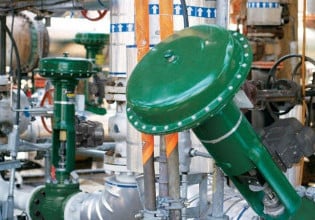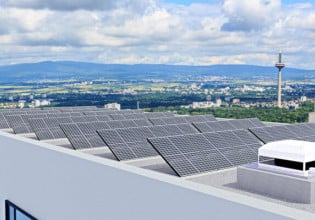ABB Doubles HVDC Capacity and Celebrates 20th Anniversary
Over 60 years ago, ABB introduced a technology that would transform the world of power. A new way of transmitting electricity across long distances with minimum losses – High Voltage Direct Current or HVDC. Since then, the company has commissioned more than half the global HVDC installed base – setting many world records in the process.
In 1997 ABB had another HVDC breakthrough. A new voltage sourced converter or VSC solution – using advanced power electronics for greater controllability, making smaller HVDC systems economical. It’s called it HVDC Light. The latest generation of that technology has recently doubled power capacity to over 3000MW and distance capability to 2000 km – delivering 350% more power per sqm
The vision was to create a more efficient, controllable and financially viable technology to supplement the traditional HVDC systems at the time. While developing HVDC Light, the ABB team had three key engineering breakthroughs.
First – a new transistor semiconductor device for high power applications. This was a fully controllable switching device that combined the low-loss long distance power transfer capacity of HVDC with voltage support. It helped to control voltage in weak or isolated power grids.
Second- the new control and protection system for HVDC, called MACH, developed by ABB engineers – providing additional computing and control capability.
A third breakthrough was the introduction of lighter cables for HVDC applications. These extruded polymer underground and marine cables were easier and faster to install than the traditional cable systems used at the time.
ABB engineers worked with VB Elnät – a subsidiary of the Swedish energy company, Vattenfall – to deploy the technology at a pilot project in Hällsjön, Sweden. In 1997 we gave birth to HVDC Light after successful trial tests.
At the time, it was a modest 3MW pilot application, operating with a dc voltage and current of 10kV and 150 Amps. Yet, it included advanced features: a mixed overhead and cable dc system, electronic load current breakers, islanding and remote access.
The new Voltage Sourced Converter (VSC) technology was called HVDC Light to resemble a more elegant, lighter and agile version of HVDC. It used less footprint and had less electric circuit equipment. It was superior in its ability to control the ac voltage, phase angle and currents compared with the classic HVDC technology or any existing ac technology.
Within the first decade, eight additional transmission systems were commissioned across the world ranging from underground, marine and back-to-back converters as well as those positioned on offshore platforms. During this time, the power capacity was increased from 3MW to 350MW and at the same time the team successfully optimized switching patterns to reduce losses in the converter.
Some of the major projects during this period included Gotland Light in Sweden, the Terranora Interconnector and Murray Link in Australia, Tjaereborg in Denmark, the Cross Sound cable and Eagle Pass in the USA, Troll 1-2 in Norway and Estlink from Finland to Estonia.
The uptake of the technology started to spread among transmission system operators. Many of these projects have spurred the integration of renewable energy and electricity trading. Some of the recent landmark projects deploying this technology include: BorWin1 and DolWin1 in Germany’s North Sea integrating energy from remote offshore wind farms and supplying clean power to millions; Skagerrak 4 that connects Denmark and Norway to balance renewable wind with hydroelectric power. It is the first VSC link that operates at 500kVdc; and Caprivi link in Namibia, a 950km overhead line connecting Namibia’s capital, Gerus, with the Zambezi converter station in Namibia’s Caprivi region near the Zambian border. The VSC stations give ‘black start’ support and enables the integration of power markets.
Examples of projects currently in construction are the North Sea Link and NordLink between Norway and the networks in UK and Germany, respectively. The links will deploy 1400MW bipolar HVDC schemes to connect and balance Norwegian hydro power with wind-rich UK and German and grids, respectively.
On the technology front we have covered significant ground in the past two decades. We have raised power capacity from 50MW to more than 1,400MW – enough to power several million households. We have enhanced voltage levels from 80kV to 525kV, thereby increasing distance capability from 70km to over 1,000km. And at the same time we have continually brought down transmission losses which are now at less than 1 percent.
Now, on the 20th anniversary of HVDC Light, has more than double power capacity to over 3000MW and by enhancing voltage levels further to 640kV, doubling the distance capability to 2000 km without compromising on losses. This also means a much more compact solution – with a potential to deliver 350 percent more power per square meter of space used – a huge benefit in applications like offshore wind transmission, city center in-feeds or interconnections. And the latest ABB Ability-based MACH control and protection system will provide greater efficiency and reliability. All this can bring substantial cost benefits, facilitate more interconnections and greater integration of renewables, lowering environmental impact.
These latest developments can significantly influence the way power systems are planned and operated. HVDC Light is a versatile technology to integrate renewable energy efficiently and safely between power markets as we build a smarter, stronger and greener grid.
In contrast to the classic HVDC technology, that use a strong ac grid to commutate a thyristor-based converter, the HVDC Light system controls the ac grid with converters based on IGBTs. HVDC Light can now support any ac grid with various power quality requirements such as reactive power compensation, voltage support, and black start.
These features have been key enabling factors in early deployment of the technology. They connect remote offshore wind farms that are fundamentally in black start mode or bring power to islands such as Åland in the Finnish archipelago – where a real black start trial operation took place during commissioning.






